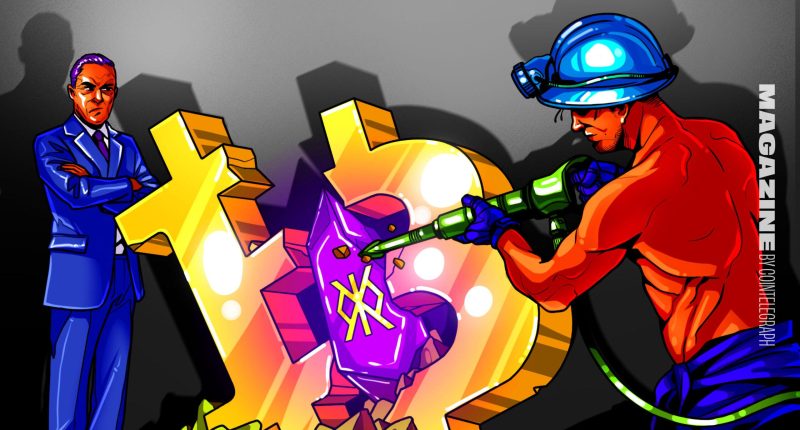The Bitcoin halving event is usually a one-token show. But this year, it shared the stage with the much-anticipated debut of Runes, a new fungible token protocol that stole the spotlight.
The Runes launch was accompanied by massive hype around the potential of memecoins on the protocol and, to a lesser extent, a fresh functionality for the Bitcoin network to tap into the growing interest in DeFi.
Despite initial enthusiasm, Runes has received its fair share of criticism due to its role in escalating Bitcoin’s transaction fees and failure to generate profits for most investors.
On halving day, Bitcoin fees soared to record highs, resulting in a generous revenue bump for miners despite their 50% pay cuts on block rewards. The roaring activity didn’t translate into profits for investors, as the top 50 Runes by number of holders are down 30% on average as of April 29, OKX data shows. Two-thirds of them (34 out of 50) are in the red.
Advocates maintain that it’s premature to discount Runes, as developers envision a future where the protocol evolves to provide more substantial utility, facilitating improved trading experiences and broader adoption within the Bitcoin ecosystem.

“I’ve been there when other protocols launched [and] they all sucked in the first few days,” Quary, the pseudonymous founder of Bitcoin marketplace Magisat, tells Magazine.
“I see no reason not to be bullish [on Runes] in the medium or long term.”
New use cases for Bitcoin unlocked
The hype surrounding Runes was “undoubtedly” immense, according to Benjamin Charbit, CEO of metaverse firm Darewise Entertainment, a genesis member of the decentralized Bitcoin protocol Opal.
A big part of the excitement surrounding Runes comes from the potential ability of memecoins to onboard new retail users into the Bitcoin ecosystem.
Runes can expand the functionality of the Bitcoin blockchain by enabling users to tokenize various real-world assets such as real estate, stocks, commodities, or even other cryptocurrencies such as stablecoins.
This capability opens up new possibilities for DeFi applications and other use cases within the Bitcoin ecosystem.
Read also
Features
Experts want to give AI human ‘souls’ so they don’t kill us all
Features
Sell or hodl? How to prepare for the end of the bull run, Part 2
“Today’s Runes interface is likely not the final iteration, with promising prospects for enhanced user-friendly applications and services on the horizon,” says Charbit.
But while the future may have more practical plans for Runes other than being the latest crypto casino, memecoins are mainly what they are today.
As of April 29, there were more than 349,000 Runes holders, according to data from Rune Alpha. That’s almost half of the active addresses on the network as tracked by on-chain data firm IntoTheBlock.
Lucas Outumuro, head of research at IntoTheBlock, points out that Bitcoin’s new addresses have dropped to their lowest levels in two years.

Following the halving, new addresses dropped to around 267,000. It has more or less stayed in that range apart from a few spikes, suggesting that the activity is still dominated by veteran users and degens rather than retail investors.
Mike Chavez, an evangelist also known as “Goodthings,” claimed in a recent X Spaces session hosted by Cointelegraph that the early infrastructure for Runes is “superior to any other fungible token standard in crypto history.”
As Chavez pointed out, Runes was accessible on applications such as crypto wallet Xverse from day one.
“We’ve seen a huge uptick in new users at the launch of Runes,” Ken Liao, the CEO of Xverse, tells Magazine.

“BRC-20 tokens also proved that people want memecoins on Bitcoin,” he says.
BRC-20 tokens and Runes
Although it’s only a little over a year old, BRC-20 was the fungible token standard on Bitcoin prior to Runes.
BRC-20s have a complex structure using Ordinals — Bitcoin’s iteration of nonfungible tokens — that require users to bundle up BRC-20s into NFT-like assets to make transactions. It’s a bit of a faff, so Ordinals creator Casey Rodarmor came up with Runes as an improvement.
Runes offers a more streamlined approach to creating fungible tokens on Bitcoin’s blockchain, addressing the clutter of unspent transaction outputs (UTXOs) that often plague BRC-20 tokens. It kicks off transactions by pinpointing unused UTXOs, giving these digital leftovers a new purpose.
“Runes is an attractive option for investors who are looking for efficient token solutions but may not understand or want to deal with the complexity of creating NFT-like assets that are required by BRC-20s,” Jonathan Thomas, CEO of decentralized finance platform Blueberry Protocol, tells Magazine.
“As Runes stick around, more users are going to hop on board when they see an alternative that allows them to create tokens just as degens do, making Bitcoin’s network more accessible,” Thomas adds.
Should Bitcoin Miners celebrate fee revenue bump?
Bitcoin’s proof-of-work consensus mechanism sees miners solve complex algorithmic problems to verify transactions and they are rewarded in Bitcoin.
The latest halving cut mining rewards from 6.25 Bitcoin to 3.125, meaning a pay cut for miners, which usually results in some miners switching off machines.
But in a complete reversal of the usual order of things, Bitcoin miners started making more money on halving day rather than less. Miners had one of their best weekends following the halving, raking in $107 million on April 20 alone. Over 75% of that came from transaction fees thanks to Rodarmor’s Runes and Ordinals (including the hunt for “Epic Sats“).
Read also
Features
Which gaming guild positioned itself best for the bull market?
Features
ZK-rollups are ‘the endgame’ for scaling blockchains: Polygon Miden founder
“Bitcoin fees have dropped since the initial release of Runes, but still remain two to three times larger than they were the week before,” Outumuro tells Magazine.
“Miners should expect more transaction fee revenue coming in due to Runes, but it is likely to be very cyclical,” he says. “When the market is risk-on, the revenue will be significantly higher than during risk-off periods.”

Quarry added that most fee spikes would come from the minting of Runes rather than trading them.
He singles out Z•Z•Z•Z•Z•FEHU•Z•Z•Z•Z•Z, the first Rune created after the genesis Rune (UNCOMMON•GOODS), as one of the main culprits that drove exorbitant fees at halving as it processed 1.1 million mints.
Trading activities may pump fees as well “but not significantly” because “most of the heavy lifting will be passed to centralized exchanges where non to little on-chain activity actually happens,” he says.
Less than a week into existence, Runes project DOG•GO•TO•THE•MOON by Leonidas, co-founder of Ordinals explorer Ord.io, started trading on the exchange Gate.io.
Not all trading activities will occur off-chain as more decentralized exchanges for Runes are expected to pop up.
Bitcoin Runes can be more than memecoins
The early iterations of Runes are mostly, if not all, fueled by memecoin experiments, but that isn’t necessarily the end game.
According to Franklin Templeton, an investment firm with $1.6 trillion in assets under management, Runes positions Bitcoin to close the gap with Ethereum and Solana’s fungible tokens markets.
Read also
Columns
Wall Street disaster expert Bill Noble: Crypto spring is inevitable
Features
The DeFi bots pumping Solana’s stablecoin volume
Runes enhances the BRC-20 approach by reducing the buildup of UTXOs.
This excess can clog the network and drive up fees, but Runes streamlines the process, keeping the blockchain running more smoothly.
“This helps avoid creating excess data that can potentially bloat the blockchain. This method also allows for embedding multiple token transfers with a single transaction, which, of course, will reduce the total number of transactions and data nodes have to process,” says Thomas of Blueberry Protocol.

An efficient, fungible token standard is a necessity for DeFi, which unlocks a myriad of financial services on-chain.
Popular decentralized services on Ethereum, the largest chain for DeFi with over $54 billion in total value locked, include decentralized exchanges, as well as lending and borrowing platforms. These use cases are facilitated by fungible tokens such as stablecoins.
“Runes remains a pivotal trendsetter, especially as more memecoins and novel projects infuse utility into their Rune tokens,” Charbit says, adding that Opal is prepared to add utility, such as governance and in-game currency mechanics, to its tokens.
According to Liao of Xverse, general users may not yet feel the potential of Runes as only the “very basic infrastructure” is currently live.
“But the underlying protocol has improvements which in the future could lead to a much better experience in trading and other applications,” Liao says.
Subscribe
The most engaging reads in blockchain. Delivered once a
week.


Yohan Yun
Yohan Yun is a multimedia journalist covering blockchain since 2017. He has contributed to crypto media outlet Forkast as an editor and has covered Asian tech stories as an assistant reporter for Bloomberg BNA and Forbes. He spends his free time cooking, and experimenting with new recipes.
Also Read More: World News | Entertainment News | Celebrity News









